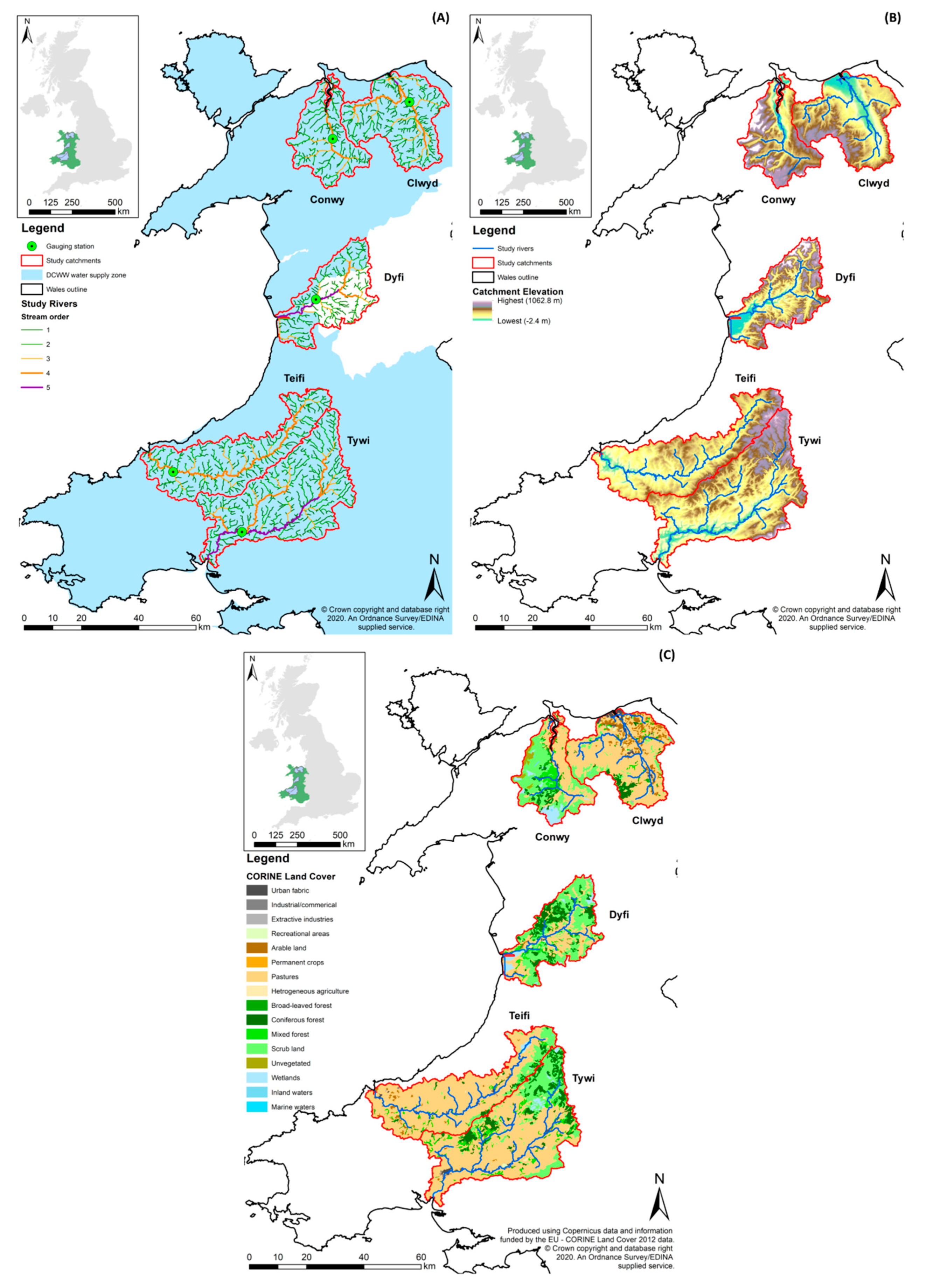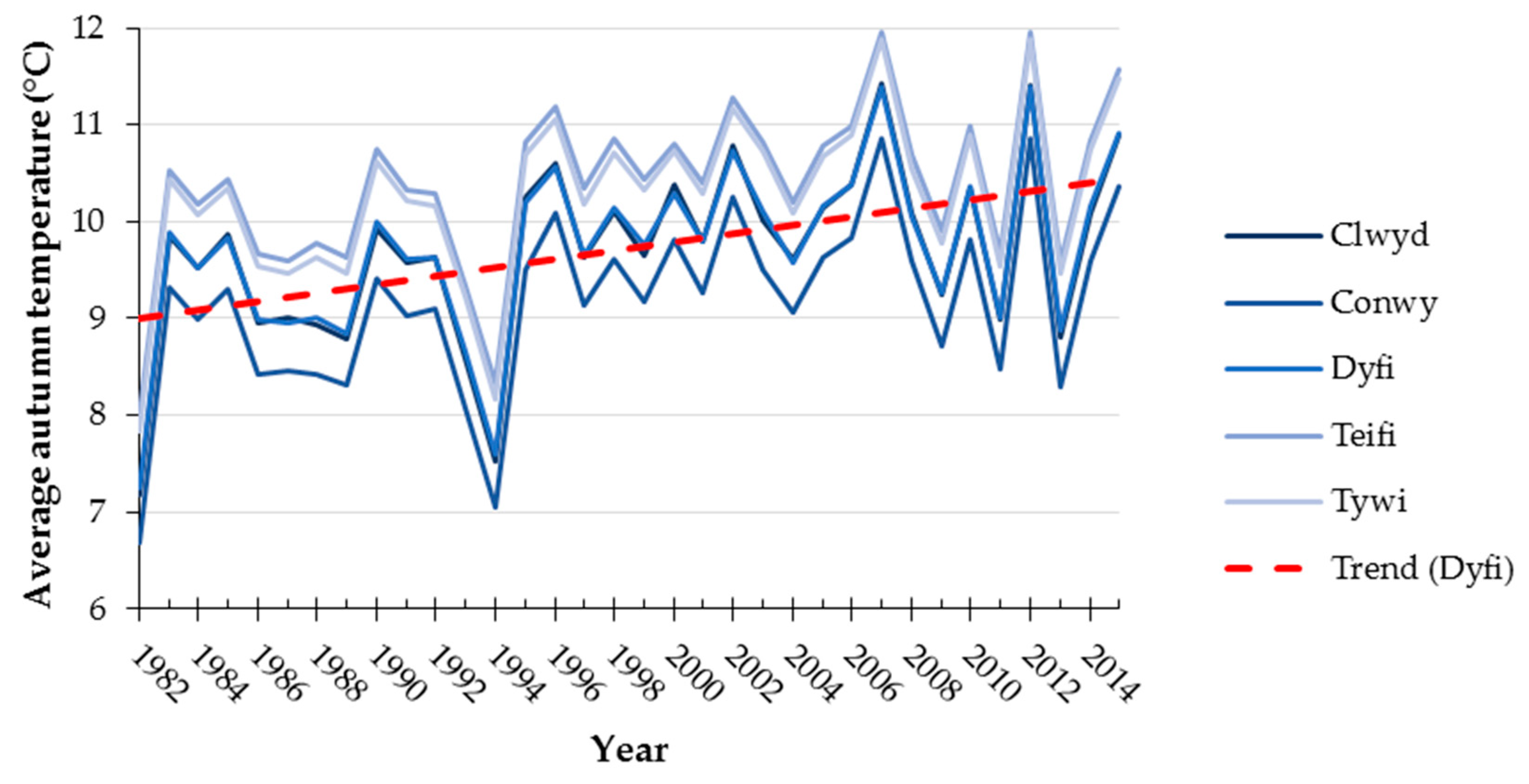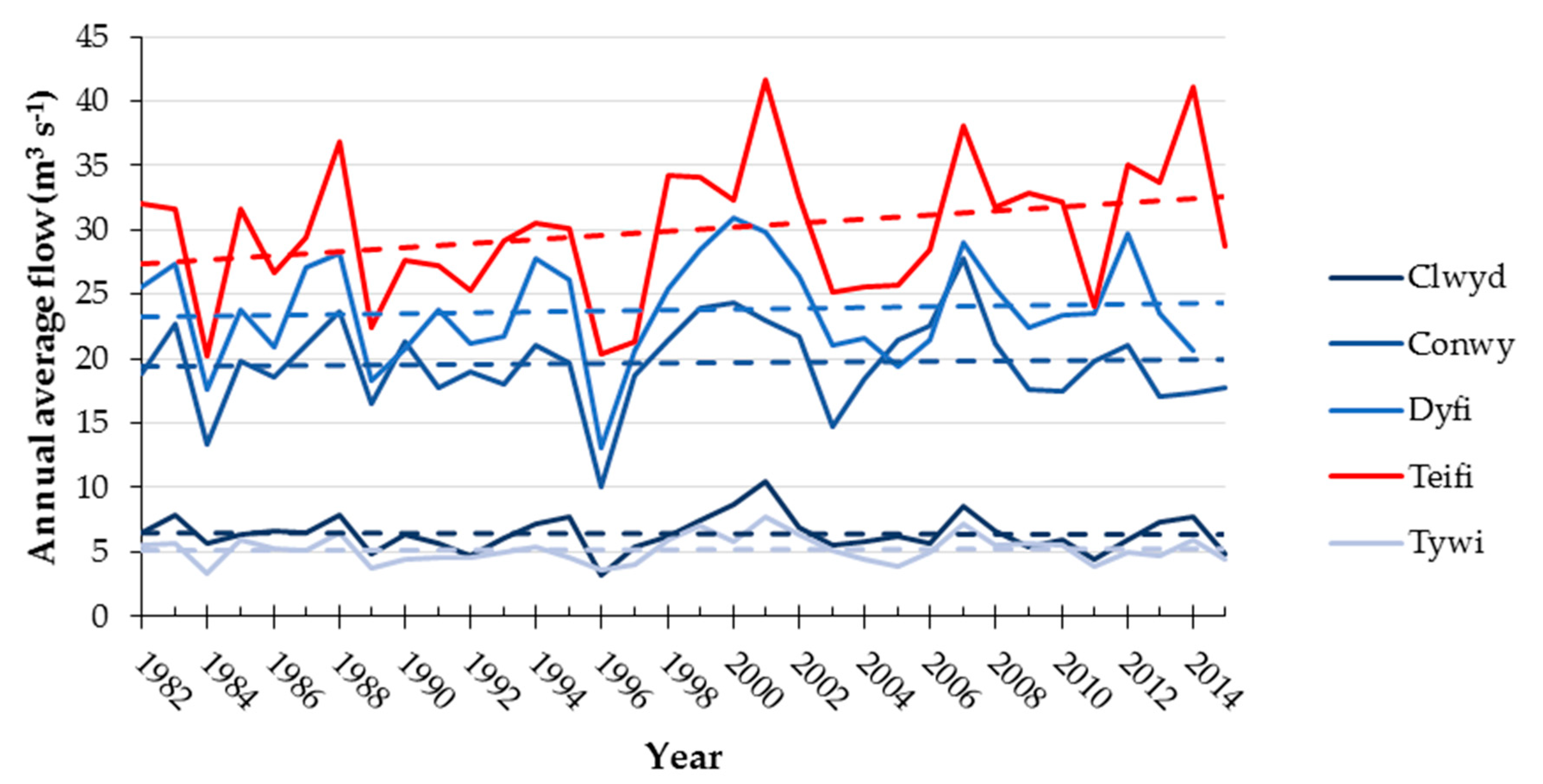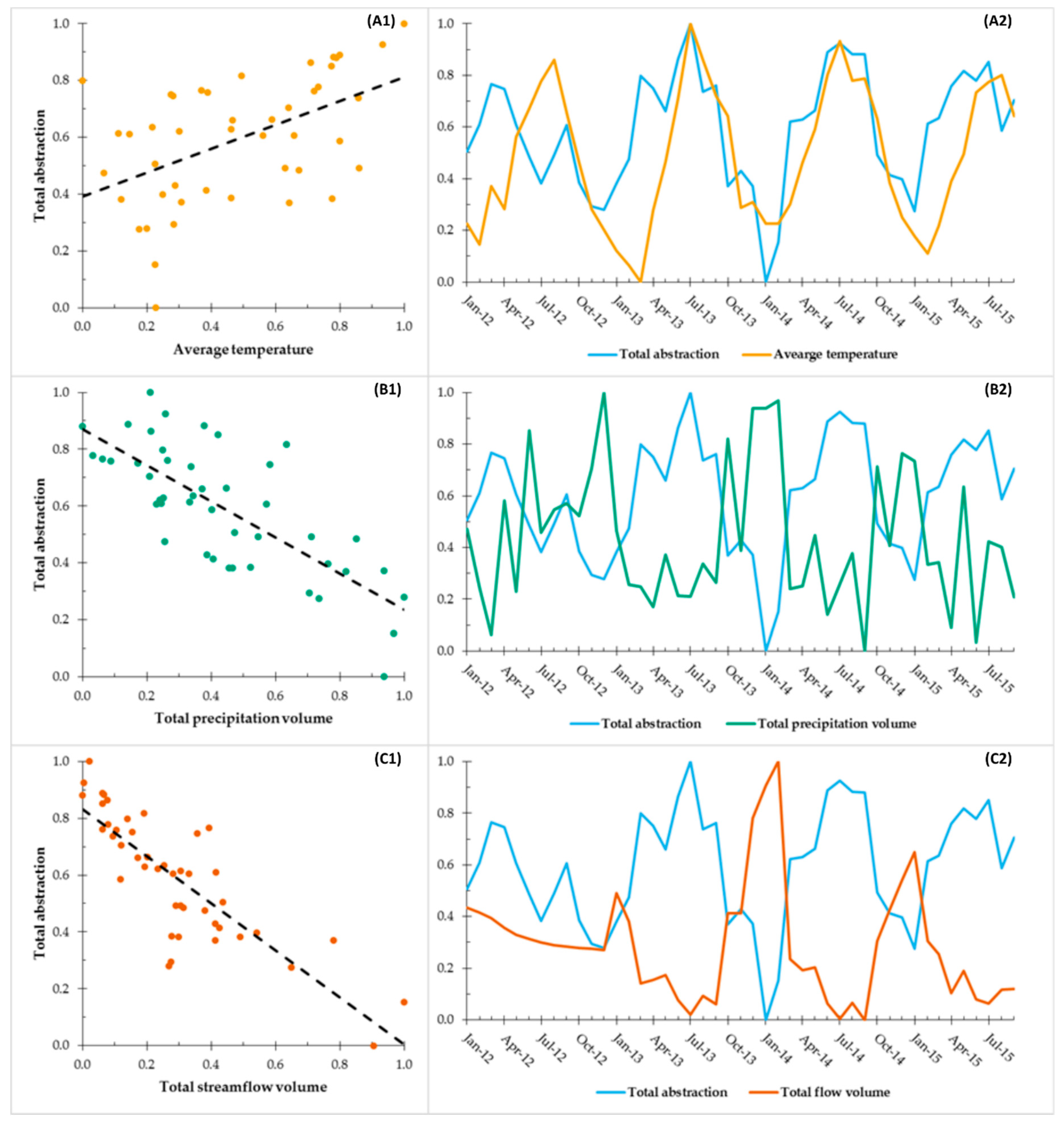Influence of Historical Climate Patterns on Streamflow and Water Demand in Wales, UK
Abstract
1. Introduction
2. Data and Methods
2.1. Study Catchments
2.2. Data
2.3. Trend Analysis
2.4. Correlation Analysis of Hydroclimatic and Abstraction Data
3. Results
3.1. Trend and Breakpoint Analysis
3.1.1. Precipitation
3.1.2. Temperature
3.1.3. Streamflow
3.2. Correlation Analysis of Hydroclimatic and Abstraction Data
4. Discussion
4.1. Hydroclimatic Trends
4.2. Weather and Demand for Water
4.3. Study Implications
5. Conclusions
Author Contributions
Funding
Acknowledgments
Conflicts of Interest
References
- Brown, L.E.; Mitchell, G.; Holden, J.; Folkard, A.; Wright, N.; Beharry-Borg, N.; Berry, G.; Brierley, B.; Chapman, P.; Clarke, S.J.; et al. Priority water research questions as determined by UK practitioners and policy makers. Sci. Total. Environ. 2010, 409, 256–266. [Google Scholar] [CrossRef] [PubMed]
- Watts, G.; Battarbee, R.W.; Bloomfield, J.P.; Crossman, J.; Daccache, A.; Durance, I.; Elliott, J.A.; Garner, G.; Hannaford, J.; Hannah, D.M.; et al. Climate change and water in the UK–Past changes and future prospects. Prog. Phys. Geogr. 2015, 39, 6–28. [Google Scholar] [CrossRef]
- Suggitt, A.; Maclean, I.; Critchlow, R.; Beale, C.; Rowcroft, P.; White, C. Aggregate Assessment of Climate Change Impacts on the Goods and Benefits Provided by the UK’s Natural Assets; AECOM Limited: London, UK, 2015. [Google Scholar]
- Whitehead, P.G.; Wilby, R.L.; Battarbee, R.W.; Kernan, M.; Wade, A. A review of the potential impacts of climate change on surface water quality. Hydrol. Sci. J. 2009, 54, 101–123. [Google Scholar] [CrossRef]
- Christierson, B.V.; Vidal, J.-P.; Wade, S.D. Using UKCP09 probabilistic climate information for UK water resource planning. J. Hydrol. 2012, 424–425, 48–67. [Google Scholar] [CrossRef]
- Prudhomme, C.; Young, A.; Watts, G.; Haxton, T.; Crooks, S.; Williamson, J.; Davies, H.; Dadson, S.; Allen, S. The drying up of Britain? A national estimate of changes in seasonal river flows from 11 Regional Climate Model simulations. Hydrol. Process. 2012, 26, 1115–1118. [Google Scholar] [CrossRef]
- Mayes, J. Changing regional climatic gradients in the United Kingdom. Geogr. J. 2000, 166, 125–138. [Google Scholar] [CrossRef]
- Diaz-Nieto, J.; Wilby, R.L. A comparison of statistical downscaling and climate change factor methods: Impacts on low flows in the River Thames, United Kingdom. Clim. Chang. 2005, 69, 245–268. [Google Scholar] [CrossRef]
- Wilby, R.L.; Harris, I. A framework for assessing uncertainties in climate change impacts: Low-flow scenarios for the River Thames, UK. Water Resour. Res. 2006, 42, 02419. [Google Scholar] [CrossRef]
- Wilby, R.L.; Whitehead, P.G.; Wade, A.J.; Butterfield, D.; Davis, R.J.; Watts, G. Integrated modelling of climate change impacts on water resources and quality in a lowland catchment: River Kennet, UK. J. Hydrol. 2006, 330, 204–220. [Google Scholar] [CrossRef]
- Arnell, N.W. Incorporating climate change into water resources planning in England and wales. J. Am. Water Resour. Assoc. 2011, 47, 541–549. [Google Scholar] [CrossRef]
- Cloke, H.L.; Jeffers, C.; Wetterhall, F.; Byrne, T.; Lowe, J.; Pappenberger, F. Climate impacts on river flow: Projections for the Medway catchment, UK, with UKCP09 and CATCHMOD. Hydrol. Process. 2010, 24, 3476–3489. [Google Scholar] [CrossRef]
- Whitehead, P.G.; Crossman, J.; Balana, B.B.; Futter, M.; Comber, S.; Jin, L.; Skuras, D.; Wade, A.J.; Bowes, M.J.; Read, D.S. A cost-effectiveness analysis of water security and water quality: Impacts of climate and land-use change on the River Thames system. Philos. Trans. R. Soc. A Math. Phys. Eng. Sci. 2013, 371, 20120413. [Google Scholar] [CrossRef] [PubMed]
- Borgomeo, E.; Hall, J.W.; Fung, F.; Watts, G.; Colquhoun, K.; Lambert, C. Risk-based water resources planning: Incorporating probabilistic nonstationary climate uncertainties. Water Resour. Res. 2014, 50, 6850–6873. [Google Scholar] [CrossRef]
- Capell, R.; Tetzlaff, D.; Soulsby, C. Will catchment characteristics moderate the projected effects of climate change on flow regimes in the Scottish Highlands? Hydrol. Process. 2013, 27, 687–699. [Google Scholar] [CrossRef]
- Capell, R.; Tetzlaff, D.; Essery, R.; Soulsby, C. Projecting climate change impacts on stream flow regimes with tracer-aided runoff models-preliminary assessment of heterogeneity at the mesoscale. Hydrol. Process. 2014, 28, 545–558. [Google Scholar] [CrossRef]
- Baggaley, N.J.; Langan, S.J.; Futter, M.N.; Potts, J.M.; Dunn, S.M. Long-term trends in hydro-climatology of a major Scottish mountain river. Sci. Total. Environ. 2009, 407, 4633–4641. [Google Scholar] [CrossRef]
- Blenkinsop, S.; Fowler, H.J. Changes in drought frequency, severity and duration for the British Isles projected by the PRUDENCE regional climate models. J. Hydrol. 2007, 342, 50–71. [Google Scholar] [CrossRef]
- Fowler, H.J.; Wilby, R.L. Detecting changes in seasonal precipitation extremes using regional climate model projections: Implications for managing fluvial flood risk. Water Resour. Res. 2010, 46, 03525. [Google Scholar] [CrossRef]
- Dixon, H.; Lawler, D.M.; Shamseldin, A.Y. Streamflow trends in western Britain. Geophys. Res. Lett. 2006, 33, 19406. [Google Scholar] [CrossRef]
- Thompson, J.R.; Iravani, H.; Clilverd, H.M.; Sayer, C.D.; Heppell, C.M.; Axmacher, J.C. Simulation of the hydrological impacts of climate change on a restored floodplain. Hydrol. Sci. J. 2017, 62, 2482–2510. [Google Scholar] [CrossRef]
- MET Office. UK Climate Averages. Available online: http://www.metoffice.gov.uk/public/weather/climate#?region=wales (accessed on 28 May 2020).
- DCWW. Trading and Procurement Code; Dŵr Cymru Welsh Water: Treharris, Wales, 2016. [Google Scholar]
- Warren, A.J.; Holman, I. Evaluating the effects of climate change on the water resources for the city of Birmingham, UK. Water Environ. J. 2012, 26, 361–370. [Google Scholar] [CrossRef][Green Version]
- Prudhomme, C.; Jakob, D.; Svensson, C. Uncertainty and climate change impact on the flood regime of small UK catchments. J. Hydrol. 2003, 277, 1–23. [Google Scholar] [CrossRef]
- Hannaford, J. Climate-driven changes in UK river flows: A review of the evidence. Prog. Phys. Geogr. 2015, 39, 29–48. [Google Scholar] [CrossRef]
- Burt, T.P.; Howden, N.J.K.; Worrall, F. The changing water cycle: Hydroclimatic extremes in the British Isles. Wiley Interdiscip. Rev. Water 2016, 3, 854–870. [Google Scholar] [CrossRef]
- Henriques, C.; Garnett, K.; Weatherhead, E.K.; Lickorish, F.A.; Forrow, D.; Delgado, J. The future water environment—Using scenarios to explore the significant water management challenges in England and Wales to 2050. Sci. Total Environ. 2015, 512–513, 381–396. [Google Scholar] [CrossRef] [PubMed]
- Macdonald, N.; Phillips, I.D.; Mayle, G. Spatial and temporal variability of flood seasonality in Wales. Hydrol. Process. 2010, 24, 1806–1820. [Google Scholar] [CrossRef]
- NIC. Preparing for a Drier Future: England’s Water Infrastructure Needs; National Infrastructure Committee: London, UK, 2018.
- Butler, D.; Memon, F. Water Demand Management, 1st ed.; IWA Publishing: London, UK, 2006. [Google Scholar]
- Herrington, P.R. Climate Change and the Demand for Water; Her Majesty’s Stationery Office: London, UK, 1996. [Google Scholar]
- Downing, T.E.; Butterfield, R.E.; Edmunds, B.; Knox, J.W.; Moss, S.; Piper, B.S.; Weaterhead, E.K. Climate Change and Demand for Water; Stockholm Environment Institute: Oxford, UK, 2003. [Google Scholar]
- Browne, A.; Medd, W.; Anderson, B. Developing novel approaches to tracking domestic water demand under uncertainty—A reflection on the “up scaling” of social science approaches in the United Kingdom. Water Resour. Manag. 2013, 27, 1037–1038. [Google Scholar] [CrossRef][Green Version]
- Balling, R.C.; Gober, P. Climate variability and residential water use in the city of Phoenix, Arizona. J. Appl. Meteorol. Climatol. 2007, 46, 1130–1137. [Google Scholar] [CrossRef]
- Gutzler, D.S.; Nims, J.S. Interannual variability of water demand and summer climate in Albuquerque, New Mexico. J. Appl. Meteorol. 2005, 44, 1777–1787. [Google Scholar] [CrossRef]
- Chang, H.; Praskievicz, S.; Parandvash, H. Sensitivity of urban water consumption to weather and climate variability at multiple temporal scales: The case of Portland, Oregon. Int. J. Geospat. Environ. Res. 2014, 1, 7. [Google Scholar]
- Goodchild, C.W. Modelling the impact of climate change on domestic water demand. Water Environ. J. 2003, 17, 8–12. [Google Scholar] [CrossRef]
- Parker, J.; Wilby, R.L. Quantifying household water demand: A review of theory and practice in the UK. Water Resour. Manag. 2013, 27, 981–1011. [Google Scholar] [CrossRef]
- Mann, H.B. Nonparametric Tests Against Trend. Econometrica 1945, 13, 245–259. [Google Scholar] [CrossRef]
- Kendall, M.G. Rank Correlation Methods, 3rd ed.; Griffin Publishers: London, UK, 1975. [Google Scholar]
- Kundzewics, Z.W.; Robson, A.J. Change detection in hydrological records-A review of the methodology. Hydrol. Sci. J. 2004, 49, 7–19. [Google Scholar] [CrossRef]
- Hamed, K.H.; Ramachandra Rao, A. A modified Mann-Kendall trend test for autocorrelated data. J. Hydrol. 1998, 204, 182–196. [Google Scholar] [CrossRef]
- Helsel, D.R.; Hirsch, R.M. Statistical Methods in Water Resources; United States Geological Survey: Reston, VA, USA, 2002.
- Mwangi, H.M.; Julich, S.; Patil, S.D.; McDonald, M.A.; Feger, K.-H. Relative contribution of land use change and climate variability on discharge of upper Mara River, Kenya. J. Hydrol. Reg. Stud. 2016, 5, 244–260. [Google Scholar] [CrossRef]
- Murphy, C.; Harrigan, S.; Hall, J.; Wilby, R.L. Climate-driven trends in mean and high flows from a network of reference stations in Ireland. Hydrol. Sci. J. 2013, 58, 755–772. [Google Scholar] [CrossRef]
- Basarin, B.; Lukić, T.; Pavić, D.; Wilby, R.L. Trends and multi-annual variability of water temperatures in the river Danube, Serbia. Hydrol. Process. 2016, 30, 3315–3329. [Google Scholar] [CrossRef]
- Hajani, E.; Rahman, A.; Ishak, E. Trends in extreme rainfall in the state of New South Wales, Australia. Hydrol. Sci. J. 2017, 62, 2160–2174. [Google Scholar] [CrossRef]
- Jaiswal, R.K.; Lohani, A.K.; Tiwari, H.L. Statistical analysis for change detection and trend assessment in climatological parameters. Environ. Process. 2015, 2, 729–749. [Google Scholar] [CrossRef]
- Sen, P.K. Estimates of the regression coefficient based on Kendall’s Tau. J. Am. Stat. Assoc. 1968, 63, 1379. [Google Scholar] [CrossRef]
- Alexandersson, H. A homogeneity test applied to precipitation data. J. Climatol. 1986, 6, 661–675. [Google Scholar] [CrossRef]
- Alexandersson, H.; Moberg, A. Homogenization of Swedish temperature data. Part I: Homogeneity test for linear trends. Int. J. Climatol. 1997, 17, 25–34. [Google Scholar] [CrossRef]
- Pettitt, A.N. A non-parametric approach to the change-point problem. J. R. Stat. Soc. Ser. C (Appl. Stat.) 1979, 28, 126. [Google Scholar] [CrossRef]
- Hänsel, S.; Medeiros, D.M.; Matschullat, J.; Petta, R.A.; de Mendonça Silva, I. Assessing homogeneity and climate variability of temperature and precipitation series in the capitals of North-Eastern Brazil. Front. Earth Sci. 2016, 4, 389. [Google Scholar] [CrossRef]
- Hawkins, D.M. Testing a sequence of observations for a shift in location. J. Am. Stat. Assoc. 1977, 72, 180–186. [Google Scholar] [CrossRef]
- Beranova, R.; Huth, R. Time variations of the relationships between the North Atlantic Oscillation and European winter temperature and precipitation. Stud. Geophys. Geod. 2007, 51, 575–590. [Google Scholar] [CrossRef]
- West, H.; Quinn, N.; Horswell, M. Regional rainfall response to the North Atlantic Oscillation (NAO) across Great Britain. Hydrol. Res. 2019, 50, 1549–1563. [Google Scholar] [CrossRef]
- Osborn, T.J.; Hulme, M. Evidence for trends in heavy rainfall events over the UK. Philos. Trans. R. Soc. London. Ser. A Math. Phys. Eng. Sci. 2002, 360, 1313–1325. [Google Scholar] [CrossRef]
- Wheater, H.; Evans, E. Land use, water management and future flood risk. Land Use Policy 2009, 26, S251–S264. [Google Scholar] [CrossRef]
- Welsh Government. June 2019 Survey of Agriculture and Horticulture: Results for Wales; Welsh Government: Cardiff, Wales, 2019.
- Welsh Government. Woodlands for Wales Indicators 2014-15; Welsh Government: Cardiff, Wales, 2015.
- Dessai, S.; Hulme, M. How do UK climate scenarios compare with recent observations? Atmos. Sci. Lett. 2008, 9, 189–195. [Google Scholar] [CrossRef]
- Nesbitt, A.; Kemp, B.; Steele, C.; Lovett, A.; Dorling, S. Impact of recent climate change and weather variability on the viability of UK viticulture-combining weather and climate records with producers’ perspectives. Aust. J. Grape Wine Res. 2016, 22, 324–335. [Google Scholar] [CrossRef]
- Luterbacher, J. European seasonal and annual temperature variability, trends, and extremes since 1500. Science 2004, 303, 1499–1503. [Google Scholar] [CrossRef] [PubMed]
- Osborn, T.J. Winter 2009/2010 temperatures and a record-breaking North Atlantic Oscillation index. Weather 2011, 66, 19–21. [Google Scholar] [CrossRef]
- Slavíková, L.; Malý, V.; Rost, M.; Petružela, L.; Vojáček, O. Impacts of climate variables on residential water consumption in the Czech Republic. Water Resour. Manag. 2013, 27, 365–379. [Google Scholar] [CrossRef]
- Xenochristou, M.; Kapelan, Z.; Hutton, C. Using smart demand-metering data and customer characteristics to investigate influence of weather on water consumption in the UK. J. Water Resour. Plan. Manag. 2020, 146, 04019073. [Google Scholar] [CrossRef]
- Massoud, E.C.; Purdy, A.J.; Miro, M.E.; Famiglietti, J.S. Projecting groundwater storage changes in California’s Central Valley. Sci. Rep. 2018, 8, 12917. [Google Scholar] [CrossRef]
- Met Office. UK Climate Projections: Headline Findings; Met Office: Exeter, UK, 2019.
- Betts, R.A.; Alfieri, L.; Bradshaw, C.; Caesar, J.; Feyen, L.; Friedlingstein, P.; Gohar, L.; Koutroulis, A.; Lewis, K.; Morfopoulos, C.; et al. Changes in climate extremes, fresh water availability and vulnerability to food insecurity projected at 1.5 °C and 2 °C global warming with a higher-resolution global climate model. Philos. Trans. R. Soc. A Math. Phys. Eng. Sci. 2018, 376, 20160452. [Google Scholar] [CrossRef] [PubMed]
- King, A.D.; Karoly, D.J. Climate extremes in Europe at 1.5 and 2 degrees of global warming. Environ. Res. Lett. 2017, 12, 114031. [Google Scholar] [CrossRef]
- Slingo, J. The Recent Storms and Floods in the UK; Met Office: Exeter, UK, 2014.
- Harkness, C.; Semenov, M.; Areal, F.; Senapati, N.; Trnka, M.; Balek, J.; Bishop, J. Adverse weather conditions for UK wheat production under climate change. Agric. For. Meteorol. 2020, 282–283, 107862. [Google Scholar] [CrossRef] [PubMed]








| River | Catchment Area (km2) | Main Channel Length (km) | Mean Catchment Slope (degrees) | Catchment Land Use/Land Cover (%) | ||||
|---|---|---|---|---|---|---|---|---|
| Urban | Agricultural | Forest | Scrub * | Wetland | ||||
| Clwyd | 803 | 35 | 7.1 | 3.7 | 80.3 | 7.2 | 8.8 | 0.0 |
| Conwy | 564 | 43 | 10.7 | 1.6 | 32.3 | 13.2 | 40.7 | 7.9 |
| Dyfi | 676 | 42 | 14.2 | 0.4 | 30.6 | 20.1 | 43.2 | 5.1 |
| Teifi | 1011 | 80 | 6.6 | 0.9 | 83.1 | 5.5 | 9.5 | 1.1 |
| Tywi | 1363 | 109 | 9.2 | 0.7 | 64.6 | 16.0 | 17.1 | 1.3 |
| River | Kendall’s Tau | Sen’s Slope |
|---|---|---|
| Clwyd | 0.337 | 0.041 |
| Conwy | 0.348 | 0.040 |
| Dyfi | 0.344 | 0.038 |
| Teifi | 0.337 | 0.038 |
| Tywi | 0.344 | 0.038 |
| River | Pettitt p-Value | SNHT p-Value | % Change in 1994–2015 Mean from 1982–1993 Mean |
|---|---|---|---|
| Clwyd | 0.001 | 0.009 | +12.2% |
| Conwy | 0.002 | 0.008 | +12.7% |
| Dyfi | 0.003 | 0.011 | +11.8% |
| Teifi | 0.002 | 0.010 | +10.3% |
| Tywi | 0.003 | 0.010 | +10.6% |
| River | Factor | Kendall’s Tau | Sen’s Slope |
|---|---|---|---|
| Conwy | Number of summer days below temperature dataset 5th percentile | −0.271 | −0.125 |
| Dyfi | Number of days annually above temperature dataset 95th percentile | −0.165 | −0.250 |
| Number of summer days below temperature dataset 5th percentile | −0.260 | −0.133 | |
| Teifi | Number of days annually above temperature dataset 95th percentile | −0.173 | −0.250 |
| Number of summer days below temperature dataset 5th percentile | −0.269 | −0.143 | |
| Tywi | Number of days annually above temperature dataset 95th percentile | −0.191 | −0.286 |
| Number of summer days below temperature dataset 5th percentile | −0.266 | −0.136 |
| River | Factor | Kendall’s Tau | Sen’s Slope |
|---|---|---|---|
| Clwyd | Annual one day maximum | 0.239 | 0.406 |
| Conwy | Summer one day maximum | 0.252 | 1.882 |
| Winter one day minimum | 0.193 | 0.030 | |
| Dyfi | Summer one day maximum | 0.222 | 1.341 |
| Annual one day maximum | 0.184 | 1.238 | |
| Spring one day minimum | 0.339 | 0.065 | |
| Summer one day minimum | 0.317 | 0.048 | |
| Annual one day minimum | 0.355 | 0.045 | |
| Teifi | Winter one day maximum | 0.269 | 2.037 |
| Spring one day minimum | 0.237 | 0.071 | |
| Summer one day minimum | 0.237 | 0.059 | |
| Annual one day minimum | 0.254 | 0.056 | |
| Tywi | Autumn one day minimum | 0.239 | 0.019 |
| Summer one day minimum | 0.348 | 0.012 | |
| Annual one day minimum | 0.320 | 0.011 |
| River | Hydroclimatic Variable | Daily | Monthly | ||
|---|---|---|---|---|---|
| Pearson’s r | Spearman’s ρ | Pearson’s r | Spearman’s ρ | ||
| Clwyd | Temperature | 0.369 | 0.403 | 0.619 | 0.665 |
| Precipitation | −0.181 | −0.225 | −0.509 | −0.485 | |
| Streamflow | −0.615 | −0.553 | −0.868 | −0.808 | |
| Conwy | Temperature | 0.197 | 0.197 | 0.279 | 0.248 |
| Precipitation | −0.111 | −0.182 | −0.415 | −0.381 | |
| Streamflow | −0.169 | −0.298 | −0.389 | −0.429 | |
| Dyfi | Temperature | −0.398 | −0.404 | −0.372 | −0.250 |
| Precipitation | −0.054 | −0.140 | -0.171 | −0.250 | |
| Streamflow | 0.012 | 0.018 | 0.055 | −0.014 | |
| Teifi | Temperature | 0.073 | 0.094 | 0.094 | 0.125 |
| Precipitation | −0.073 | −0.082 | −0.147 | −0.256 | |
| Streamflow | −0.117 | −0.235 | −0.148 | −0.374 | |
| Tywi | Temperature | 0.177 | 0.218 | 0.485 | 0.482 |
| Precipitation | −0.165 | −0.202 | −0.768 | −0.724 | |
| Streamflow | −0.509 | −0.559 | −0.942 | −0.961 | |
| Combined | Temperature | 0.207 | 0.252 | 0.504 | 0.489 |
| Precipitation | −0.190 | −0.223 | −0.755 | −0.729 | |
| Streamflow | −0.547 | −0.581 | −0.925 | −0.943 | |
© 2020 by the authors. Licensee MDPI, Basel, Switzerland. This article is an open access article distributed under the terms and conditions of the Creative Commons Attribution (CC BY) license (http://creativecommons.org/licenses/by/4.0/).
Share and Cite
Dallison, R.J.H.; Patil, S.D.; Williams, A.P. Influence of Historical Climate Patterns on Streamflow and Water Demand in Wales, UK. Water 2020, 12, 1684. https://doi.org/10.3390/w12061684
Dallison RJH, Patil SD, Williams AP. Influence of Historical Climate Patterns on Streamflow and Water Demand in Wales, UK. Water. 2020; 12(6):1684. https://doi.org/10.3390/w12061684
Chicago/Turabian StyleDallison, Richard J. H., Sopan D. Patil, and A. Prysor Williams. 2020. "Influence of Historical Climate Patterns on Streamflow and Water Demand in Wales, UK" Water 12, no. 6: 1684. https://doi.org/10.3390/w12061684
APA StyleDallison, R. J. H., Patil, S. D., & Williams, A. P. (2020). Influence of Historical Climate Patterns on Streamflow and Water Demand in Wales, UK. Water, 12(6), 1684. https://doi.org/10.3390/w12061684







